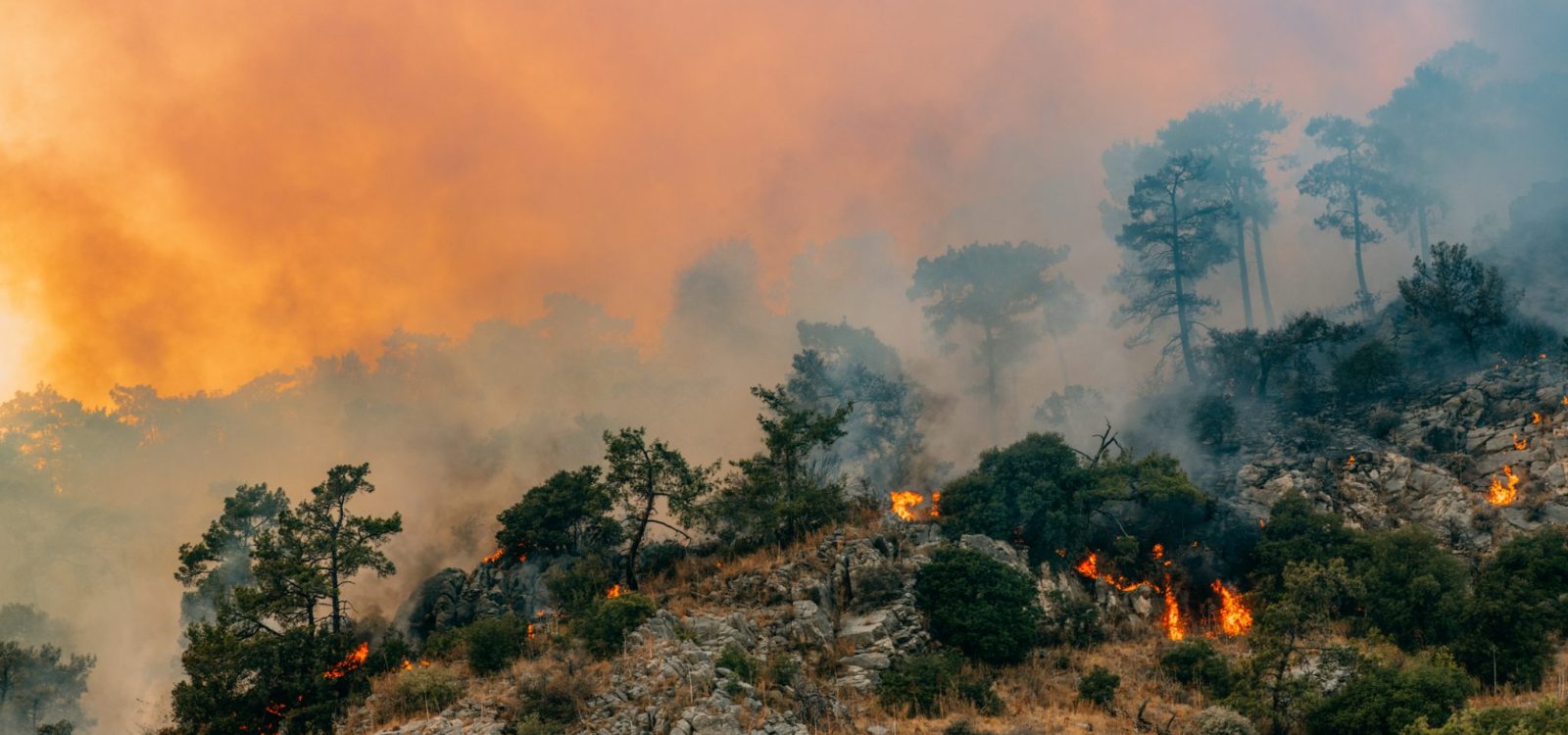
Climate Change Risk and Opportunity for the General Insurance Actuary
Extreme weather and decarbonisation are affecting us now.
July 4, 2023, wasn’t just a date of significance for our American friends celebrating their 247th year of independence; it was in the middle of a four-day stretch of the hottest global mean surface air temperature recorded in the Copernicus ERA5 database, which goes back to 1940.[1] Meanwhile, residents of major cities in North America experienced choking smoke from wildfires in Canada and water temperatures off the coast of Florida reached 101.1F (38.4C), threatening widespread bleaching of coral reefs.[2]
In Europe, heat, dry vegetation and wind gusts led to fires that burned 135,000 hectares in 12 days, which is in addition to the 260,000 hectares previously burnt in 2023.[3] China set a national daily temperature record in July and Beijing was hit by the heaviest rainfall in 140 years.[4]
On our shores, many capital cities registered their highest July temperatures ever, and there are clear warning signs of a dangerous bushfire season ahead. These are the latest in a long series of extremes providing mounting evidence that climate change is a danger to people and the financial institutions that insure their assets.
The message of the Intergovernmental Panel on Climate Change (IPCC) on this is clear. Quoting from the IPCC–International Actuarial Association paper “Climate Science: A Summary for Actuaries”[5]:
Recent changes in the climate are widespread, rapid, and intensifying.
They are unprecedented in thousands of years. It is indisputable that human activities are causing climate change. Human influence is making extreme climate events, including heatwaves, heavy rainfall and droughts, more frequent and severe.
While these challenges are real and create financial risk for general insurers, they will open major opportunities for new products and markets…
Beyond extreme weather and rising seas, energy infrastructure is moving to renewable sources and electrification. Firms face stricter reporting requirements and exposure to litigation for both environmental damage and failing to properly disclose information on investments or emissions.
Corporate planners must also consider political risk, as polarisation may lead to sudden changes in policies following elections. All of this will affect general insurers and the actuaries who provide services to them. Like the advent of spreadsheets, laptop computers, the internet, catastrophe modelling and DFA, this new challenge will have a significant impact on actuarial practice.
The good news: opportunities arise
The good news is that with increasing risk comes the opportunity for astute management of it by traders of risk, and that includes general insurers, which have the capacity and responsibility to embrace emerging challenges to bring new value propositions to society.
The notion that general insurers can ignore this because they can reprice contracts annually, that political gridlock in the U.S. will block the type of regulatory action that are seen abroad, or that the rate regulation process will mute any price changes should be considered in the context of:
- Insurers seeing a surge in losses from extreme weather in the present.
- Reinsurance markets factoring both recent events and climate projections into their largely unregulated prices.
- Government pools exposing insurers to deficit assessments.
- The National Flood Insurance Program facing significant fiscal challenges due to rising sea levels and extreme precipitation; if it raises prices to match risk, many properties will become uninsured and decline in value, impacting customer bases and opening the door to litigation over whether insured wind or uninsured water causes losses.
- Electric vehicles and green building practices affecting both what is insured and how it is repaired.
- Rising litigation risk due to allegations of greenwashing and liability for environmental damage.
- Increasing reporting requirements, which will impact firms across the economy; even if U.S. regulators are slow to act, the fact that many U.S. insurers operate internationally or are publicly traded will force them to meet demands for more disclosure.
While these challenges are real and create financial risk for general insurers, they will open major opportunities for new products and markets, in addition to creating a need for the type of risk analysis actuaries excel in to support resilience and adaptation measures.
Systems thinking: A key skill
Climate risk requires a more holistic view, as it is quintessentially systemic. It goes beyond catastrophic events to the interaction of climate and human systems. Breaching of climate tipping points can have cascading effects on complex systems. Consider a natural catastrophe having knock-on effects of property destruction, business interruption, stressed supply chains, damage to ecosystems and possibly a humanitarian crisis.
Currently, many systems are underprepared to withstand projected changes in both climate and the economy, which is likely to lead to diverse forms of stress on communities, businesses and political systems.
History is full of such examples, including two recent events. In 2010 extreme weather caused a large decline in wheat production and a consequent spike in global grain prices. The resulting surge in the cost of bread in many developing countries placed great stress on significant parts of the population and many countries’ political systems. Also in 2010, massive flooding in Thailand triggered by an abnormal late season monsoon significantly disrupted key suppliers of automobile parts, affecting manufacturers around the world.[6]
This systemic risk has ramifications for the general insurance industry through potential underwriting losses or declines in asset prices. Beyond direct effects, climate change can threaten the business model of general insurance. Historically reliable premium and profit sources may shrink in geographies and industries exposed to climate change, thereby rendering significant portions of insurers’ books of business less viable.
New approaches are needed
Climate change risk necessitates new approaches to general insurance business. Climate-specific scenario analysis will supplement traditional catastrophe models to understand the potential impact of extreme events. Advanced analytics techniques will be needed to project how various acute and chronic hazards may affect risk over time. Actuarial assessments will need to reflect future projections derived from climate science in addition to the historical insurance experience that currently informs pricing and reserving.
There are opportunities for general insurers to bring new products to market, such as the insuring of electric vehicles, customising the coverage for homes with solar panels, managing workers’ compensation risk across rising and declining industries, and many more. In addition, growth in the value at risk and higher volatility increases the demand for new and different insurance solutions. Insurers have an opportunity to offer innovative approaches to cover newer and more frequent hazards, both acute, such as wildfires, and chronic, such as reduced crop yields.
Insurers can also play a role in matching risk-transfer solutions to alternative capital from investors with more risk appetite. A case in point is a World Bank-led transaction to protect an Uruguayan state-owned electric power company against drought (which would cripple hydroelectric production) as well as against high oil prices (which would make power generation costly).[7]
Actuarial skills can also be applied to public policy projects, such as future-proofing building codes and land use policies or redesigning government pool mechanisms to address affordability issues in high-risk areas.
Noteworthy studies have emerged which delve deeply into understanding flood risks and the mitigation of wildfires. One particular piece of research titled “Climate, Spatial Dependence, and Flood Risk: A U.S. Case Study”[8] explores the connection between social and climatic factors, offering insights into the driving forces behind flood and climate trends. Another significant paper is “Catastrophe Models for Wildfire Mitigation: Quantifying Credits and Benefits to Homeowners and Communities,”[9] which delves into the pivotal role of catastrophe models in bolstering community resilience and ensuring the affordability of insurance admis escalating climate risk. To find out more about these reports, visit the CAS website.

The future
General insurers have a chance to play a major role in confronting climate change as stakeholders demand that insurance solutions go beyond traditional risk transfer to explicitly address climate risk adaptation and seize new opportunities. Insurers can help organisations adapt, and in this way, protect a greater share of the global economy.
To take full advantage, general insurers need to understand the consequences and knock-on effects of specific climate hazards within the context of different sectors and geographic areas. By adapting the tools we use in our traditional work, such as catastrophe and economic capital models, actuaries can tackle the problem of determining the optimal investment that societies should make in climate change mitigation and adaptation. To achieve this, we need to broaden our continuing education to include climate topics and get involved in multidisciplinary groups working on climate-related issues.
As the demand for climate disclosure increases, it quickly becomes evident that addressing the uncertainty in forecasts and understanding the confidence scientists have in them is critical. Insurers must think of the future not as a single point estimate, but a range of possible states that should be considered stochastically.
Actuaries are uniquely positioned to guide decision makers through this maze by creating cohesive narratives around the magnitude of the risk faced and appropriate responses. This can emphasise the importance of taking evasive action against risk while “right-sizing” the response, considering costs and benefits over time.
With diligence and foresight, we can position ourselves as crucial agents in building the economy of the future based on sustainable practices.
This article was originally published in Actuarial Review and has been republished here with the permission of the authors and the Actuarial Review Team. You can view the original article here.
Authors Alp Can, FCAS, and Rade Musulin, ACAS, are members of the International Actuarial Association’s Climate Risk Task Force.
References
[1] https://climate.copernicus.eu/july-2023-sees-multiple-global-temperature-records-broken
[2] https://www.npr.org/2023/07/26/1190218132/florida-ocean-temperatures-101-marine-life-damage
[3] https://joint-research-centre.ec.europa.eu/jrc-news-and-updates/wildfires-mediterranean-monitoring-impact-helping-response-2023-07-28_en
[4] https://public.wmo.int/en/media/news/exceptional-heat-and-rain-wildfires-and-floods-mark-summer-of-extremes
[5] “Climate Science: A Summary for Actuaries”, IPCC and International Actuarial Association, page 4, https://www.actuaries.org/IAA/Documents/Publications/Papers/Climate_Science_Summary_Actuaries.pdf
[6] “Climate-Related Scenarios Applied to Insurers and Other Financial Institutions,” International Actuarial Association, Section 5, https://www.actuaries.org/IAA/Documents/Publications/Papers/CRTF_Application_Climate_Scenarios.pdf
[7] https://www.worldbank.org/en/results/2018/01/10/uruguay-insurance-against-rain-oil-prices
[8] https://www.casact.org/sites/default/files/2022-12/RP_ClimateSpatialDependence_FloodRisk.pdf
[9] https://www.casact.org/sites/default/files/2022-10/RP_Cat_Models_for_Wildfire_Mitigation.pdf
CPD: Actuaries Institute Members can claim two CPD points for every hour of reading articles on Actuaries Digital.






